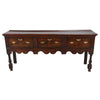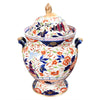
Things We Love 2
Any antique dealer will tell you the two most exciting parts of the job are discovering a gem to buy and finding one of those gems a home (i.e. SELLING!). After decades in the trade and thousands of finds, the first part of that equation comes naturally. A certain piece will captivate us almost immediately. While it can seem an entirely subjective phenomenon, there are definite criteria that always come into play. Those criteria are illustrated beautifully in this recently acquired corner cabinet and a few of them are as follows:

FORM: The first feature of a piece to note is the overall form, much like you would initially take in the composition of a painting. We are constantly seeking out forms that stand out in some way or many ways. While the general form of this corner cabinet (2 doors over 2 doors) is nothing unusual, there is quite a bit in the details that is. Most obvious of those is the scrolling vine motif and the buds? the acorns? the rosehips? that are growing on them. Whether these are meant to be a stylistic representation of some real-life plant or a figment of the creator's imagination is beside the point. In fact, the mystery is part of the fun. The motif, however, does serve to fill the rails of the cabinet carcass with a visually pleasing stimulus. The undulating, organic nature of the vines serves to break up the inherently boxy nature of the cabinet, and is echoed in the arched panels of the upper doors and the floral medallions below the cornice. Some other nice details which also break up the "straight line" shape are the turned split moldings just below the cornice and on the interior shelf front, the half-round pilasters of the lower section, and the roundels above those pilasters.

PROPORTIONS: Walking hand-in-hand with Form is Proportions. In the case of this particular piece, we love the slender proportions. In addition to its advantages in terms of commercial considerations (i.e. finding a corner wide enough to place it), the narrowness gives this piece a vertical quality, again lessening the sense of "boxiness" (not that there's anything wrong with that). We also love the low-waisted proportions of this piece. Typically, we look for pieces with a 1/3-2/3 relationship between the lower section and upper. While this one doesn't quite hit that mark, the waist does is significantly below the halfway point, which avoids the "Mom Jeans" vibe of other high-waisted pieces (not that there's anything wrong with Mom Jeans).
COLOR/PATINA: While these two traits go hand-in-hand (much like form and proportions), they aren't interchangeable. Color can be described as the underlying hue while patina refers to the accumulated surface on top which consists of decades of dirt, grime, ash, and wax. In the case of this piece and any piece with outstanding color, the term "colors" might be a better term. This piece ranges from a deep auburn (without getting TOO red) to a mellow caramel. All these various tones, the result of sunlight hitting the piece in different areas, retain a richness, a warmth and a mellowness. Atop these lovely colors, the patina is most prevalent in the nooks and crannies of the moldings, the carving, and the knots of the wood. There is a dark crustiness built up there that adds further nuance and drama to the underlying color.

TIMBER: The fact that this corner cabinet is made of elm (or it actually could be a highly figured ash) sets it apart from the more typical varieties which come in pine, oak, or mahogany. Whether or not the casual observer could identify the wood species, they could easily appreciate the exuberance of the figuring in the grain.
AUTHENTICITY: This piece wears its age on its sleeve, and we mean that in a good way. The panels have warped in such a way that gives them a bowed appearance and feel, just as you'd expect for a piece of wood with so much movement to the grain. There is evidence of dormant woodworm. There are also several "honest" repairs. For us, authenticity doesn't mean that a piece is devoid of any repairs. Sometimes a piece that is too pristine makes you wonder if it is too good to be true. For instance, we have had to replace the plinth of this piece. As it likely sat on a damp floor for much of its life, the existing plinth was in such a state of rot that it wasn't serving its function of supporting the case. Now that the repair has been made, the piece should stand up to a couple more centuries of use just nicely.
If you've read all these many words to the bitter end, we thank you. We imagine if comments were allowed, we'd get several TL;DR's. But if you did stick it out, we hope you appreciated a little bit of insight into our process. We don't necessarily tick all these boxes in mechanical fashion, but they are always in the back of our mind. In short, these are all just a bunch of words that boil down to: "We think this is a beautiful and interesting piece, and we'd love for you to have it."



























